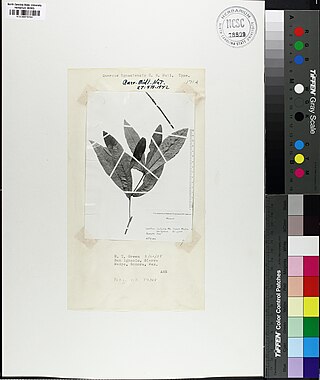
Quercus petraea, commonly known as the sessile oak, Cornish oak, Irish Oak or durmast oak, is a species of oak tree native to most of Europe and into Anatolia and Iran. The sessile oak is the national tree of Ireland, and an unofficial emblem in Wales and Cornwall.

Quercus pontica, the Pontine oak or Armenian oak, is a species of endangered oak currently extant to the western Caucasus mountains of Georgia and northeastern Turkey where it grows at altitudes of 1,300–2,100 metres.

Quercus dentata, also called Japanese emperor oak or daimyo oak is a species of oak native to East Asia. The name of the tree is often translated as "sweet oak" in English to distinguish it from Western varieties. It is placed in section Quercus.

Quercus faginea, the Portuguese oak, is a species of oak native to the western Mediterranean region in the Iberian Peninsula. Similar trees in the Atlas Mountains of northwest Africa are usually included in this species, or sometimes treated as a distinct species, Quercus tlemcenensis. It occurs in mountains from sea level to 1,900 metres above sea level, and flourishes in a variety of soils and climates. Out of all the oak forests in the Iberian Peninsula, the southern populations of Portuguese oak were found to have the highest diversity and endemism of spider species.

Quercus devia is a species of oak tree in the family Fagaceae, native to northwestern Mexico. The tree is endemic to the Sierra de la Laguna range of the Peninsular Ranges system, located in the southern part of the Baja California Sur state of Mexico. It grows in Sierra de la Laguna pine-oak forests habitats. It is an IUCN Red List endangered species, threatened by habitat loss. It is placed in section Lobatae.
Quercus macdougallii is a species of plant in the family Fagaceae. It is placed in section Quercus.

Quercus purulhana is a species of oak native to Mexico and Central America. It is found in Belize, Guatemala, Honduras, Nicaragua, and the Chiapas state of southern Mexico. It is a montane forest species. It is an IUCN Red List near-threatened species, threatened by habitat loss. It is placed in section Quercus.
Quercus vicentensis is a species of oak tree in the family Fagaceae, native to southern Mexico and northern Central America. It is placed in section Quercus.

Quercus acuta, the Japanese evergreen oak, is an oak native to Japan, South Korea, Taiwan, and China's Guizhou Province and Guangdong Province. It is placed in subgenus Cerris, section Cyclobalanopsis.

Quercus lanata, the woolly-leaved oak, is a species of Quercus native to southern and southeastern Asia, including India, Bhutan, Nepal, Indochina, and southwestern China. It is a large evergreen tree up to 30 metres tall. The leaves are thick and leathery, green on top but covered in thick wool on the underside. It is classified in subgenus Cerris, section Ilex.

Quercus rotundifolia, the holm oak or ballota oak, is an evergreen oak native to the western Mediterranean region, with the majority on the Iberian Peninsula and minor populations in Northwest Africa. The species was first described by Jean-Baptiste Lamarck in 1785. It is the typical species of the Iberian dehesa or montado, where its sweet-astringent acorns are a source of food for livestock, particularly the Iberian pig. Its acorns have been used for human nourishment since the Neolithic era. It is placed in section Ilex. Some authors described it as a subspecies of Quercus ilex.
Quercus asymmetrica is an oak tree species in the beech family Fagaceae. It is found in China and northern Vietnam. It is placed in subgenus Cerris, section Cyclobalanopsis.

Quercus pyrenaica, commonly known as Pyrenean oak, is a tree native to southwestern Europe and northwestern North Africa. Despite its common name, it is rarely found in the Pyrenees Mountains and is more abundant in northern Portugal and north and northwestern Spain.
Quercus margarettae, the sand post oak or dwarf post oak, is a North American species of oak in the beech family. It is native to the southeastern and south-central United States from Virginia to Florida and west as far as Texas and Oklahoma. There are historical reports of the species growing in New York State, but it has not been seen there in years.

Quercus vulcanica is a species of flowering plant in the Fagaceae family. It is referred to by the common name Kasnak oak, and is a rare species of tree native to Lebanon, Syria, and Turkey. It is placed in section Quercus.

Quercus semecarpifolia is an Asian species of oak. It is native to the Himalayas and nearby mountains in Tibet, Afghanistan, India, Nepal, and Pakistan. It is classified in subgenus Cerris, section Ilex.
Quercus lowii is a species of oak (Quercus) native to the mountains of northern Borneo.
Quercus lineata is a species of Quercus (oak) in the beech family Fagaceae, belonging to subgenus Cerris, section Cyclobalanopsis. It was first described by Carl Ludwig von Blume.

Quercus floribunda, called the Moru oak or Mohru oak, Tilonj oak and green oak, is a species of oak native to Afghanistan, Pakistan, India's western Himalaya, and Nepal, typically found from 2,000 to 3,000 metres above sea level. It is in the subgenus Cerris, section Ilex. An evergreen tree with a dense crown reaching 30 m (98 ft), it is an important fuelwood and fodder species.

Quercus ignaciensis is a tree in the genus Quercus. It is found only in an isolated area of the Mexican state of Sonora. It grows only in a subtropical biome. It usually grows over 3 metres in height. Quercus ignaciensis was described in 1942.














